 Hillary on the Run by Sue Reich Friday, November 25, 2011
This morning I printed off the documents I made Wednesday night with the images for each category of quilts for the president's exhibition. Then I went upstairs to the gallery and mentally placed the quilts in each area. It was easy to do with the images in front of me. It would help a little bit if I knew exactly which quilts we will have. But, it looks like my plan will work: the quilts with commemorative fabrics will be in the "main gallery hall" at the top of the stairs. Also in that large area will be the quilts that don't fall into a specific category, such as the FDR Donkey Quilt. The "WOW" quilt -- the first one a visitor will see when entering the gallery will be the Historic USA quilt. Pam has seen this quilt and says it is stunning. It has appliqued portraits of all the presidents up to FDR. The first gallery will have the handkerchief quilts and possibly the Lowell crazy quilt on the slant board. The next gallery will have the pictorial-style art quilts. Perhaps I will reverse those two. I'll have to think about that. The next gallery will have the quilts Washington Plume, Harrison Rose, and Whig's Defeat. I wish we had one more of these. The furthest gallery will have the five framed commemorative handkerchiefs that we are borrowing. Most of these relate to campaigns, but one is of presidents that have been assassinated. If we are able to borrow the two signature quilts, they will go in the last gallery and the framed handkerchiefs will probably be hung throughout the gallery.
The other day when Pam found the Hillary on the Run quilt, she asked me if I wanted to include it in the exhibition. She said it was a conservative quilt and would help balance the exhibition. I gave it some thought and decided it would not fit in to the exhibition. My reasoning was that it's not necessarily a conservative quilt -- that is debatable. Also, the pattern is one-of-a-kind as far as I know. I sent an email to Pam Wednesday evening telling her I didn't think it belonged in the exhibition and why.
Thanksgiving Day I received an email back from her which said: "Don't make the mistake that many twenty-first century people do about the importance of named patterns. Nineteenth century quilters named their patterns whatever they chose, and the names varied considerably. It wasn't until the pattern companies got serious in the early 1920's and 30's that there was anything close to a naming convention, and then Brackman sealed it. I will honor your decision if it comes from somewhere else other than the pattern name."
At first her response irritated me. What exactly is she saying, anyway? Is she saying pattern names don't matter? If so, why are we including three other quilts because of their pattern names? I will have to clarify this with her. However, her challenge of my reasoning has given me the opportunity to really look at the quilt and the exhibition and think about the criteria for including a quilt. I think it was a really good exercise. I came up with some pros and cons. Pam will be in the museum tomorrow so I will discuss it further with her.
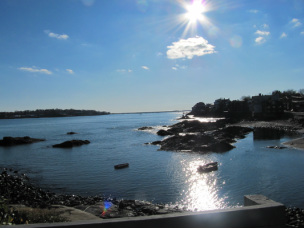 Marblehead Harbor Thanksgiving Day, 2011The director of the NEQM, Connie Barlow, and her husband, Bill, graciously invited me to spend Thanksgiving with them. Their home is in Marblehead, Mass, an historic coastal town. The drive there was about an hour. Again I had the treat of driving through some countryside and small towns, including Salem, Mass. Connie and Bill's home is a lovely 1883 three-story home. A retired architect, Bill is restoring it, room by room doing all the work himself. I knew before I came that Bill worked for the National Park Service for over thirty years. What I didn't know was that he was the lead architect and very instrumental in the design and development of the Lowell National Historic Park in the late 1960s and 1970s. This project, as you might imagine, spanned over many years and was quite complicated with all the federal, state, and local agencies and historical societies involved. After a tour of their home, and a glass of cider, Connie and Bill took me on a driving tour of Marblehead and Marblehead Neck. This area was settled about 1649. Some houses from the 17th Century are still standing. Most of those were very plain, and right next to the street. In fact, in Marblehead, most of the houses have NO YARD. The streets are narrow, windy, one-way, and crowded with homes, churches, historic meeting houses, and shops. Some of the larger homes have been converted to multi-family living spaces. When we got out on the neck (peninsula), the homes got VERY large. Many of them are on the water so you can imagine the prices. Many older homes are purchased, then torn down and a new home is rebuilt. Some of the homes here are large, some are not so big. After we left the neck, Bill parked the car and we got out for a little walk along the harbor. It was a crisp day, but sunny. The cool walk was well worth the beautiful views that it bestowed. What a wonderful tour, both walking and driving. Afterward, we went to lunch at the Yacht club, where Bill and Connie are members. Of course, it was on the water, and the view was to die for. We were seated upstairs where the view of the harbor is even better. Dinner was scrumptious and beautifully presented. We shared a wonderful bottle of wine. What interesting conversation was with these two art lovers. I loved hearing about Bill's work. His last project, before he retired last August, was designing a visitor center to be located in the basement of Faneuil Hall in Boston. When Polly and I visited there last Sunday, it was indeed in the midst of construction. Of course, this perfect day eventually drew to an end. I had to go home, but this Thanksgiving Day will be fondly remembered. Thank you Connie and Bill!
 George Washington Quilt, Florence Peto, 1968 Wednesday, Nov. 23, 2011
Pam and I spent this afternoon reviewing the quilts that will be in the Presidents exhibition and talking about where they would hang in the gallery. Generally, they fall into a few categories: presidential quilt patterns, quilts that incorporate commemorative handkerchiefs, quilts that incorporate commemorative fabrics, pictorial quilts, and then several quilts that do not fall into any category. The quilts are evenly spread into these categories -- about five or six in each. Since our gallery is chopped up into several smaller galleries, grouping these quilts together might work out very well. It would be nice to arrange them so that when the visitors arrive in the gallery, the first thing they see will be quilts using commemorative fabrics, then the first small gallery could be used for the handkerchief quilts, etc., saving the pictorial, and contemporary, quilts for last. I don't know if this will actually work out, but it might.
Pam and I also talked about a small wall in the gallery that is round. It is in a central location and now there is a large poster related the the current exhibition hung on that wall. Pam suggested painting it red or blue for the president's exhibit. I will have to think about that. Any dark color will be distracting and heavy up there. Perhaps a very light blue? We will probably have a curator's statement that will be posted on that wall.
Pam has very recently found two signature quilts she may bring in for the exhibit. They have the signatures of presidents and first ladies. The stumbling block with getting these is that they are not appraised. The quilts are in possession of a relative of the maker in Michigan. If the nephew (I think) is willing to take them to get appraised and can get it done in time, we can borrow the quilts. One quilt has signatures of all the presidents beginning with Reagan; the other has all the signatures of the first ladies beginning with Bess Truman. Since we have many quilts representing multiple presidents of the eighteenth and early nineteenth centuries, it would be nice to have one of the presidents of the 20th Century. Also, we have no other signature quilts. The matching first ladies quilt is a bonus. I really hope we are able to borrow this pair. They are very different visually from anything else in the exhibition.
This afternoon, during our meeting, Pam called a friend of hers and asked if she had a quilt for the exhibition. Her quilt is a contemporary art quilt called Hillary on the Run. She wanted to include this one because it represents conservative politics -- but does it? This is not a presidential pattern, or does it become one because the maker gave the quilt that name? This one person, the quiltmaker decides? No, I don't think so. My vote is not to include this quilt. It doesn't fit. Hillary was never elected, which brings up the subject of one other quilt slated to be in the exhibition: the Henry Clay quilt. Clay ran for President in a field of four, and was not a frontrunner. At this point, he is the only non-president represented in the exhibition. Should his quilt be there? The design is tumbling blocks, and Clay's picture is on one block in the center. I don't know off hand what the provenance of the quilt is; perhaps that is notable?
In addition to having a few potential quilts hanging out in the wings, there are two quilts that require expensive fine arts shipping. Pam and Connie have to make the decision on whether to spend the money to get those quilts. These two quilts are spectacular. I really hope they come to the NEQM in January! Then there are a few quilts Pam does not have commitments on. We may not get those.
I am frustrated that we don't know which quilts will be in the exhibit. And it's pretty challenging to write labels for quilts I don't even have decent images of. I'm sure it's been done before and somehow I will make it happen. I can write labels, but I could write better labels if I could see the quilts, or at lease better images of them.
I followed up this day at the museum by spending a few hours this evening making excel spread sheets, separating the quilts by the above categories. I created documents with images of the quilts in them, again by category. It is very helpful to have a visual of all the handkerchief quilts all together, all the pictorial quilts, etc. There are a handful of quilts I don't have images of yet. On Friday I am going to print these documents, take them up to the gallery and visualize each room with the quilts hanging.
 Holiday Express Train Tuesday, Nov 22, 2011
The NEQM Holiday Express Train was set up today. This is a holiday display that began last year. The houses, train stations, churches, and all the buildings were made by museum staff and volunteers. They are made of fabric and collapse for storage. The two trains were running. The village was adorable. While wives look at quilts, husbands and kids like to look at the trains! This Saturday there is a holiday parade in Lowell. The NEQM hopes to attract additional visitors with display. Last year was the first time it was set up. Every year a little more is added. Hopefully, it will continue to grow and become a nice attraction inside the museum.
Today I continued to learn about labels, and looked at a lot of labels from photographs I have been taking when I have visited museums here in New England. I am reading a book called Exhibit Labels by Beverly Serrell. I like her writing style and she gives lots of examples. She talks about interpretive labels and active visitor participation. Her point is to engage the museum visitor with the object. I love the idea. Now I just have to figure out how to do it.
Today I also sat down for about an hour and looked at two scrap books that are part of the museum's collection. They were donated by the family of Hala Brownell. She made these scrap books in the 1920's and 30's. They consisted of newspaper and magazine articles about quilting, quilt patterns, and knitted spreads. She also included pretty pictures and poems. I found an article in there about commemorative handkerchiefs, believe it or not. Unfortunately, I didn't find the name of the publication anywhere on it. We have five quilts in the exhibit coming in January that have commemorative handkerchiefs in them.
 Faneuil Hall also known as The Cradle of Liberty Sunday, November 20, 2011
Today I went to Boston. Polly Flanagan, a volunteer at the museum, wanted to go too, so we took off early this morning. Polly thought she could drive in, avoiding the train and subway. Since it was Sunday, we arrived in no time flat and found a parking place right away. First thing we headed for was Faneuil Hall. They were already open at 9:30 which was really nice. It was just us and the NPS Ranger. Great! I have been here before but it's a neat place to come back to again. It's a good thing we came this morning because the hall will close at 1 p.m. today to prepare for a concert this evening. Imagine attending a concert, graduation or other event in Faneuil Hall. Wouldn't that be cool? Polly and I wanted to take a walking tour of the Freedom Trail so next we headed over to the NPS Visitor Center near the Old State House. It wasn't far and the weather today was already warmer than you would expect in New England in November -- 65 degrees!
The walking tour took us to the Old State House, the Old South Meeting House, Faneuil Hall, Paul Revere's House, and the North Church. If only we could spend the entire day exploring the Freedom Trail, we could have gone to the USS Constitution, Bunker Hill, and other sites that are north of downtown Boston. Sigh.....maybe another time. I would like to have two or three days in Boston. That is not to be.
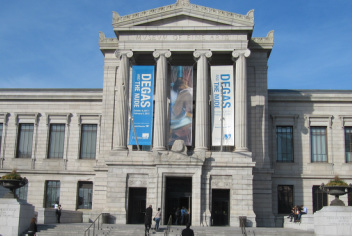 The Fine Arts Museum Next stop, the Fine Arts Museum. Polly and I hopped on the subway and were there in twenty minutes. When we were buying our tickets I asked about the Harriet Powers Bible Quilt. They told me it had been on exhibit up until November 17 -- FOUR days ago -- honestly I wanted to ring my own neck. I had checked their website and it said the Bible Quilt was on tour. If I had only known it was out, I would have done whatever was necessary to get there! Oh well, I guess you can't get everything you want -- grrrr... By this time, Polly and I were starved so we headed directly to the Cafeteria Exhibit. We ate outside in the courtyard. So so so lovely! I was wearing jeans, a cotton turtleneck, and a cotton sweater. With the sun shining, we were almost too warm. We planned to spend the day exclusively in the new North American Wing. However, on our way to lunch, we passed an exhibit we just had to go back to. Beauty and Duty was primarily a collection of English scarves printed during World War II with propaganda themes. Because nearly everything, including clothing, was rationed during the war, scarves became very popular. Manufactured by Jacqmar, a high-end London textile firm, scarves were colorful, inexpensive, and an easy way to brighten up an outfit. This fashionable accessory also gave British women an overt way to promote the war and help boost moral.
 "We shall never surrender. We shall fight in the fields and in the streets..." "The Americans in London"  Another favorite was the EMBROIDERIES of Colonial Boston exhibit. It was not a huge exhibit, but impressive. The bed curtains, chair covers, christening blanket, scarf, workbags, and petticoat borders were in wonderful condition for the most part. They were almost all mounted without glass and we could get close so as to inspect the quality of the work. The colors were vivid and I have to wonder how these aged textiles were protected so well for so many years. All the natural fibers were represented: cotton, linen, wool, and silk. During this entire day I paid particular attention to the labels -- especially what wasn't on them. I don't think I saw one that had a dimension on it. Not one. I am considering not putting the dimensions of the quilts on the labels of the Presidents exhibit. I'm not sure what Pam is going to think about that idea. The current exhibit, Art Quilts from Haiti does not include dimensions. I've seen the MFA use boldface type to help organize their labels. I am reading about labels right now, so I am really aware of them and the different presentation styles used.
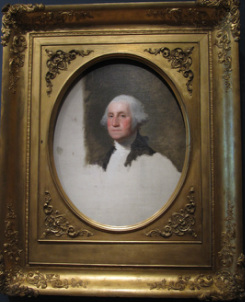 George Washington,Gilbert Stuart, 1796 We also saw some wonderful paintings by well-known American artists such as Gilbert Stuart, John Singleton Copley, and Childe Hassam I especially loved the water color and impressionist paintings. The scenes of the ocean captured my heart! We enjoyed the Folk Art and Aesthetic Movement galleries. Also the furniture...all the furniture was wonderful. It was such a treat to visit the MFA. I have never been here before. We walked 'till we dropped and finally they kicked us out at closing time. And, really, Polly and I only saw the Art of the Americas wing, and not all of it. I could spend two weeks here! What a great day!
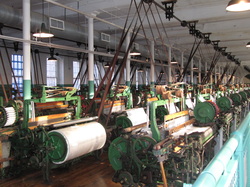 The Boott Mill weaving room Saturday, November 19, 2011
Okay, I admit it. I played hooky today. I went in to the museum this morning. I got together all the books for the President's exhibition. I spent some time in the gallery thinking about placement of the quilts. I talked to Kate about labels and found she thinks Exhibit Labels by Serrell is the "Bible" as far as labels are concerned. She also had a couple more books that touch on labels and agreed to lend them to me.
Today is past the middle of November. It's warm and sunny -- 55 degrees. I haven't taken the time to go over to Boott Mill yet, so I'm going this afternoon. I am only going to be here a few more weeks. There are still more places I want to go. Boott Mill is one of them.
Boott Mill is one of the mills that operated here in Lowell. It began with four buildings on the canal, and expanded to larger buildings. Additional buildings were added to accommodate steam power later in the 19th Century. In the mill there are still looms and many of them were running today. Fascinating! Now I could finally see just how that process works -- I watched the shuttle run between the two edges of the loom and hit the "end" and get instantly shot back to the other side. In a split second, the frame holding the warp yarns shifts, then the shuttle returns. Back and fourth, back and fourth with incredible speed. Today there were still machinists, weavers and others minding the machines. The noise was deafening and the floors vibrated. I can't imagine what it must have been like to have all the machines running at once. No wonder hearing loss was common.
Upstairs was a museum. Old carding, weaving, drafting, etc. machines were up there so you could get close. There was also a short film about industry in America and the role the New England mills played in the industrial revolution. Included in the exhibit were a number of video stations where interviews of retired mill workers were played. They echoed what I have read over and over again. The work was hard and dangerous. The mills were a way of life. Yet these former mill workers all had a certain pride about the cloth that they produced. They didn't get rich in the mills, but they could survive.
Then I went over the the Boarding House, also part of the National Park Service. Really, these girls had pretty darn good living conditions, albeit their working conditions were horrid. They also ate very well. In the boarding house was a "keeper" -- a woman who cooked for them and raised them at 4 a.m. to get to the mill and work before breakfast. They then returned to the mill until lunch and had dinner late -- seven or eight o'clock, whatever time they finished working for the day. These women put in 12 hour days five days a week, plus 10 hours or so on Saturdays. Add it up! That's a 70-hour work week. No kidding! Then on Sundays they were required to be in church; company rules. If they didn't follow the rules, there were plenty of other girls that would gladly take their jobs.
It would be quite a study to learn about the sociological impact of mill life. The first laborers in the Lowell mills were young women from their family's farms. For them, working in the mills was their first experience in independence. They got paid -- although they often didn't actually get the money (it was sent home), they learned what 'earning power' was. How did this influence women's lives and their generation as a whole? Did the "Mill Girls" newly found independence change women's attitudes that contributed to the evolution of their status in the 19th and early 20th centuries? The women's movement began in the mid-19th Century. How much did labor rights play into it?
 Friday, November 18, 2011
Today I continued on reading about political quilts, handkerchiefs, etc. I also spent some time with Maureen, teaching her a few things in Photoshop so she will be able to create images for the new website. She may at times need to post the NEQM logo on the site with no background. She hasn't done that before, so I showed her how to create a .png file. We also decided for sure to use the splash page. I set it up and inserted some images although they aren't the ones we will be using. In fact, they're pretty bad. But they provide a visual so you can see what the program can do. And THAT was the day! Gees they go by quickly sometimes!
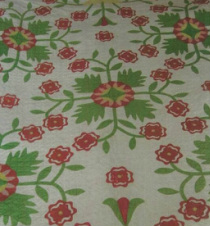 Harrison Rose Variation Thursday, November 17, 2011
My baby girl turned 21 today! Happy Birthday Miss Mozelle!
Today was dedicated to the President's exhibition. I'm reading through all the information we have received with each quilt from the owners. When the loan agreements were sent out, they were accompanied by a questionnaire. The loan agreements that have come back in have completed questionnaires. Some of them have several pages of additional information. At this point, Pam still is not sure whether she will be able to get some of the quilts she wants. She only came on board with the museum in July and has quickly put together this exhibition. Because of the short time, she still has some quilts that have not been secured. When I arrived in October, we sat down and went through all the quilts she was trying to get for the show. Surely by now we should know which ones are in and which ones are out. So, I am a little frustrated that I don't know exactly what will be in the exhibition.
I am trying to get my arms around a theme for the catalog and labels. In Serrell's label book, she calls this the "big idea." One of the thoughts I have is to categorize the quilts -- many are made with commemorative handkerchiefs, some use commemorative fabrics, some are pictorial, some have satirical themes. What am I going to hang together? What am I going to focus on in the labels beyond the obvious basic information about each one?
Pam printed off some labels the other day from the "Potholder Exhibition" she curated here last winter. She wanted me to see the format. She had taken a piece of paper and essentially cut it half with minimal information on the left side, and more detailed information on the right. She says there are two types of visitors -- those that want the 'quick and dirty' and those who will take the time to read in depth. I don't know about that, but I will say the labels from her show are awful. The information may be there, but they look like hell and there is no focus. I won't say they're unreadable. I will say they don't engage or invite readers. They are messy. Your eyes have no where to land. The two sides of the label compete with each other.
The NEQM inserts their labels into clear plexiglass and hung on the wall. The plexiglass is made to hold 81/2 x 11 paper labels. Because their budget is so tight, the possibility of posting labels of another size, or using another method is probably not an option. So, I will have to figure out a way to write the labels in this side-by-side pattern that Pam wants and make them easier to read.
 The NEQM logo and header Wednesday, November 16, 2011
Today Maureen, Polly, and I sat down and discussed strategy for moving the website content to the new site. I also spent quite a bit of time teaching them the ins and outs of the website builder. Maureen has decided, with my whole-hearted support,to build the content from scratch, taking parts from the old site, but not moving content over and "as is" with the intention to review and improve it later. This allows her to easily re-organize the site and go from there. This will be far easier, and the result will be better in the end. The NEQM does not have a huge site. Combing through each page now is a bit of a crunch, but then it's done. This is a great opportunity for Maureen, who is the PR director, to review every bit of information on their site. Some pages are out of date, some are poorly written. Maureen has been with the museum only a year. She inherited the website which was very difficult to for her to update using Dreamweaver. Many hands have contributed to the site during the past five years since it has been designed. Now Maureen can review all pages, combine like information on one page, and organize them more logically. Since Maureen writes the NEQM Newsletter, their "e-blasts," press releases, etc. she is has set a tone and style of presentation. The website should conform to these other communications. Now it will!
Maureen began building some pages on the site. Remember, now this is real -- no more test/play sites. True, it is not visible on the web, but because this is the real thing, Maureen is looking at this differently. "Now how am I actually going to use the capabilities of this site? How do I use what we have to make the best presentation?" are questions she is asking herself. She decided to put the name of the page in the red header below the logo. I think that's fine, but that box gives her the opportunity to be creative and keep the site fresh. In the pages I created for the library, I put a photo there and used a special font that seemed "scholoarly" if that makes any sense; it was sort of an Old English look. However, Maureen and Polly think the box takes up a little too much room and asked me to make the box a little bit shorter. Although I don't agree, I do have to remember the site belongs to the NEQM and they ultimately must make some of these style decisions. So, at Maureen's request, I shortened the height of the box from 183px to 140px. If the box is only used for words, no problem. But it's really a bit too small for most images. The good news is that if they change their mind, it's a no-brainer to change it back!
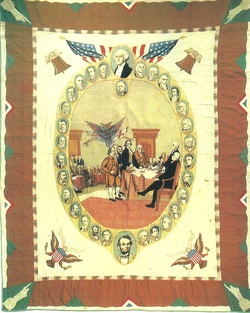 President's Medallion Tuesday, November 15, 2011
Back to work on the President's exhibition. I am gathering research materials to use for the labels and catalog. I am beginning with the questionnaire completed by the owner of the quilt. This questionnaire is sent back with the contract and provides basic details about the quilt such as size, maker, technique, materials, etc as well as any other information the owner wishes to share. Some of these quilts have come in with elaborate and detailed histories of the quilt, maker, and/or specialty fabrics that were used.
One of the things I will also be doing is reading about exhibition labels. Then I will make a recommendation about a new format for the museum to adopt. Pam would like me to consider a label with two sections: one side of the label would be a brief overview of the quilt; the other side would be a more detailed description of the quilt. This makes sense to me. But I am looking forward to reading the book I just ordered about exhibition labels.
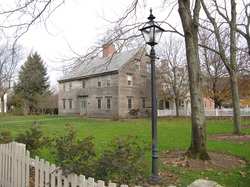 Sunday, November 13, 2011
When I arrived in Lowell, I came equipped with a "to do" list. I am slowly checking it off.. I have prioritized where I would go based on when the site closed for the winter. For example, I visited the Shelburne Museum in Vermont on October 30, the final day of their 2011 season. When I came to Massachusetts, I was surprised to find that many venues are not open year-round like in Missouri. But, if you think about it, it makes perfect sense because of the extreme and prolonged cold during the winter months. Of course, another big consideration in deciding when to go where has been the weather. Thankfully, the fall has been unseasonably warm this year. I have had beautiful weather every weekend. Today it was above 60 degrees and sunny. So, I really had a beautiful day to visit Historic Deerfield. After having visited Sturbridge Village, I thought Deerfield would be similar. I was so wrong! Deerfield is not a recreated historic town. It is an historic town that continues to exist and thrive. It is considered an important site because it is the most well documented historic town in the U.S. A few of the original structures are still standing. The homes that are part of the Historic Deerfield park are interspersed with private homes. It looks like a regular small town with really old homes! Deerfield dates back to about 1670 when settlers chose the site because it was located between two rivers and offered rich farm land. In fact the Indians had been farming there for thousands of years. Deerfield was in the thick of King Phillip's War and Indian raids were a way of life until almost 1850. After all, Deerfield was considered a western frontier -- no kidding!
In the 1940's Henry and Helen Flynt purchased a home in Deerfield and began collecting antique furniture and other decorative arts. Eventually, they established Historic Deerfield. It has several homes open to the public that depict colonial life and early American living. The home that I enjoyed touring the most was the Wells-Thorn House. Within this one house, life in different time periods is depicted. The first room was a great room from 1770. It was where everything happened -- cooking, sleeping, living. As we went from one room to another, the date advanced by 25 to 30 years. It was fascinating to see these transitions. The bedding and bed hangings progressed beautifully! The earliest beds shown had bed hangings, for privacy, no doubt. Often the bed was located in the parlor and was where callers were received. As time went along, of course the quilts and hangings became more elaborate, and were more decorative.
The thing I was most looking forward was going to the Flynt Center. This is a museum dedicated to furniture, textiles, ceramics, and other early American objects such as powder horns. They have a very nice textile gallery. The current exhibit highlights the four natural textile fibers: flax (linen), cotton, silk, and wool. Very beautiful extant garments were on exhibit for each category. Today there were a few quilts on exhibit. These were all beautiful and included palpamore, counterpane, mosaic, and wholecloth quilts as well as a woven coverlet. Darn I wish more were out! But it was still a great visit.
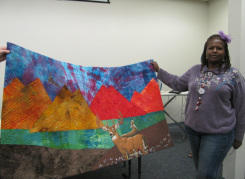 Saturday, November 12, 2011
Today Pam and I spent some time planning for the President's exhibition. Mostly it was going through what's been done so far, determining which quilts have paperwork received from their owners, which quilts we need to send out paperwork on, etc. We have a few quilts that have been identified for the show that won't be needed. The paperwork referenced here is the contract between the NEQM and the owner giving us permission to use their quilt, stating the value of the quilt for our insurance purposes, and sometimes special shipping. Two of the quilts we will be using in the show require fine arts shipping which is very expensive. Often the expense of the shipping makes certain quilts inaccessible to the museum. In addition, the contract is accompanied with a questionnaire sent by the NEQM. It gives the owner the opportunity to tell us what they already know about the quilt. Several contracts have come back with the questionnaire and a page or two (or more) of typed information about the quilt or the quilt maker. This will be very helpful when it comes to writing the labels!
This afternoon Nadege from PeaceQuilts came back to demonstrate her sewing. Also, Dr. Michele David gave a talk about her work and the work of some other African American quilt artists. She also presented a trunk show of her own work. It was fun to see her work and to have her there in person describing the inspiration, imagery and technique she uses.
 The new website Friday, November 11, 2011After having set up the website library pages yesterday, I asked our library volunteer to sit down with me to go over the way I set it up and review the changes I made. We did a little revision and moved a little text here and there. She was happy with the way it turned out and I'm glad. I had to call iPage and get a few questions answered. I have reached a stopping point with my work on the website. I think organizing the pages, transferring the data, making the pages pretty and so on is something Maureen and Polly can do just fine. I don't need to participate in that. I will need to get the splash page installed and talk with Maureen about the images we will use. I have suggested they use background images that portray classic New England themes -- winter snow and steeples, springtime might be a covered bridge, summer images might be the ocean and sailboats, and fall would, of course, be the beautiful foliage. An image of the Lowell smokestacks might also be a possibility. Now I am turning back to work on the President's exhibition coming up. Kate was in today and we were talking about putting images on the website for the collection. She wanted to know how large the images should be, etc. I am taking stock of the quilts we have scheduled for the show, what paperwork is out, etc. Pam and I are going to meet tomorrow to go over everything so I have a handle on anything she has done on the exhibition in the past two weeks while I have been working on the website.
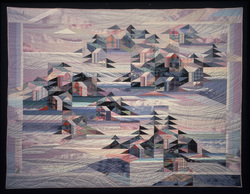 Thursday, November 10, 2011
Today was dedicated to figuring out how to put the NEQM logo on new website header. Luckily I quickly found exactly how to modify the CSS (style sheet) and index pages. Sample snippets were posted on line and I was easily able to adapt it to our needs. I plugged in the NEQM logo that I had used in the first version of Weebly that supported uploading a logo. Draught! It looks terrible now. It's all the wrong size. Believe it or not, it was quite a process to make the logo fit. I had to keep modifying the image, then the style sheet to accommodate the image size, then, do it again because it wasn't to my satisfaction. Unfortunately, there was a lot of trial and error. But the end result was a good one.
One of the things I did in styling the template was to enlarge the font for the navigation. The average age of the NEQM members is 65. As we all know, as we get older, the print somehow gets smaller. When I enlarged the navigation font, the space left to place a logo was reduced. This turned into a big balancing act. I also changed the color of the font to the NEQM gold. It looks nice!
I spent the rest of the afternoon transferring the data from the old website to the new one -- just a couple of pages for the library. I don't intend to do any more transfers than this one. I needed to do this as a test to make sure that everything was going to work -- etc. Also the librarian has asked me to add a form to the site that web visitors can fill out and submit, requesting books or asking for book suggestions. So, I grabbed an image of the library off of the old site, cropped it and threw it into the header along with some fancy lettering. It was fun and I am happy with the way it turned out.
 Some Weebly themes to pick from Wednesday, November 9, 2011
This morning began with a staff meeting. Connie sadly announced the resignation of two staff members. There was discussion of how the positions will be filled. The curator, collections manager, public relations director, etc. each gave reports. I was last and was happy to report about our plans for the website. Everyone is happy and excited about the changes.
Today we subscribed to iPage and I started rebuilding the new site. Although I didn't necessarily expect it, Maureen said she liked the template I had been using and she wants me to use it for the new site. When I chose the template, it was just because it was sort of the right color -- the NEQM colors represent New England themes -- the Red represents barn red; the deep blue represents the ocean; and the gold represents the fall foliage. They are easy colors to work with so that's good for me!
Unfortunately I can't import the site I have been working on to iPage. That would have been nice and saved me some time. But, I did it once, the second time should be easier, right? Fortunately, iPage had the same template I was using before, so that was good! So I got started today. I spent some time using Adobe Photoshop to make a header using the NEQM barn red. I started with their color, officially #990000, which is pretty bright. I added some "noise" to give it some texture, then I added a filter with lighting effects. It looks great! I am pleased. The template is pretty well done, but there is one MAJOR problem: there is nothing in this version of Weeby to upload a logo. This is a very new feature, and I have been using it. It's pretty important that we put our logo at the top of the website. The NEQM uses an unusual font that is not available in Weebly. To post the name of the museum, I have to be able to use an image. So, here we go -- back into HTML world I go!
 Weebly Themes to pick from Tuesday, November 8, 2011
Today I spent the day, once again, researching options for our new web site. We will have to move from our current web host. They also host our email, not the typical situation where the domain host also hosts the email. Because we will be changing our web host, we also have to change our email host. Weebly will be a great solution for building our new website, but they are geared toward web building. They have some basic web services in addition to building sites, but what they offer is pretty minimal. Athough they host web sites, they do not support corresponding email. So, we have to find another home for our email. Weebly suggests their users go to Google Apps and open email accounts there. NEQM could do that, but if more than 10 accounts are needed, it gets prohibitively expensive. Our existing domain host can host our email also, but they will charge a fee. Searching out the best solution gobbled up my day today.
By the end of the day, Maureen and I were talking about using a company called iPage. They support the Weebly Web Building software, email, web hosting and domain hosting. They offer the entire package. They are rated number 1 over and over again for service by their customers. This evening when I got home, I spent time on the phone talking to the people at iPage. I had to be assured that they would support us in the way we needed them to. I talked to them about the transition, etc. iPage assured me they updated their Weebly software just last week and they were in good shape. I asked a few questions to make sure they were on the same version that I have been working on. Weeby has added quite a bit of new function just in the past 30 days.
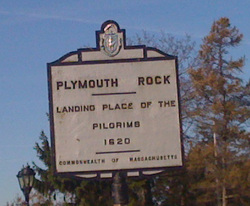 Monday, November 7, 2011This morning I drove to Plimoth Plantation in Plymouth, Massachusetts. I purposefully left after the rush hour. But I got caught in it anyway! I finally arrived about 11:00. Since it was a weekday in the fall, I thought it would be a good day to go and not contend with summer vacationers. So, there were no vacationers, but there were 1,700 elementary kids and their teachers! Ha! Ha! At least they were short people. A short introductory film was the first stop on the tour. Then the Indian village, a 17th Century English town, and lastly the Craft Center where artisans were sewing, making furniture, and making ceramic pots. This was an interesting place! I had an absolutely LOVELY warm day today to enjoy this walking tour. After leaving the Plantation, I drove to the town of Plymouth and went to see Plymouth Rock and the Mayflower II. The whole setting was beautiful. The ocean was blue, dotted with boats at the nearby marina. The Mayflower II was built in 1952 and is a replica of the original Mayflower Ship that landed at Plymouth Rock in 1620. Arriving in December, nearly half of the 100 passengers died over their first winter. Then, as the story goes, Squanto showed up and saved the day. The following fall, according to what I heard this day, the first Thanksgiving occurred on the heals of a successful harvest. Although there is some controversy about whether this really happened, here in Plymouth that's the story they're sticking to! The Mayflower II was pretty neat. It was not a large ship. There were actors there role playing passengers and crew. The quarters were tight and people were much smaller. You can see that from the small births that they slept in. According to one of the female passengers, they had quarters below deck and some families also brought the makings of a cabin so they actually had a way to build a bit of privacy into the small area on the ship they were assigned to. I asked if any passengers died during the voyage. I was amazed when I was told only two. Both were crew members. Next stop was the Pilgram Hall Museum which was only a short walk from the Mayflower II. This was certainly the highlight of my day! Built in 1824, this museum is the oldest continuously open public museum in the United States. It is not very big, but what has to offer is fantastic. There are beautiful paintings of pilgram scenes. Downstairs they have artifacts including a cradle that came over on the Mayflower, a Bible that belonged to William Bradford, the earliest known sampler made in America made by the daughter of Myles Standish. and other has been opened continuously since 1648. They also had a very informative film that traced the history of the pilgrams from when they left England to settle in Holland, and then eleven years later to the New World. Love this museum! I have an ancestor, Francis Sprague, that came from England to the New World on The Good Ship Anne, in 1623. He landed in Plymouth and so I thought it might be possible that there would be some historical information about early settlers. This museum seemed as good a place as any to ask, so I did. The woman I spoke to went immediately to a book in the gift shop called Plymouth Colony: It's History and People 1620 - 1690 by Eugene Strantton. In that book was biographical information about various colonists. I was surprised and delighted to see Francis Sprague listed! It included his arrival date, information about land and cattle divisions he participated in, his daughters that came with him, as well as children that were born in Plymouth Colony. The better part of a page was spent describing his family and business -- apparently he had one of the first taverns in the colonies tee he! :) Guess who was listed directly after Francis Sprague in this book -- why Myles Standish of course!
|






















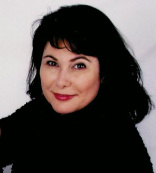
 RSS Feed
RSS Feed